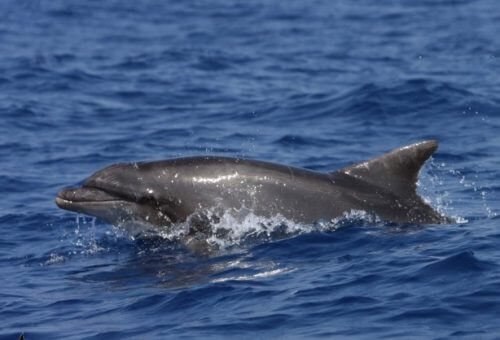Noise originating from human activity causes a harmful effect on animals in the sea and on land. Get to know noise pollution: an environmental hazard that is just beginning to be tackled

Yali Katz, Angle - news agency for science and the environment
It must have happened more than once that just when you just wanted to enjoy some quiet, one of the neighbors played loud music, started drilling in the wall or construction work was heard from the building next to you. We humans have quite a few ways to limit noise of one kind or another - whether simply by closing a window, contacting the noisy neighbor or setting regulations to prevent noise hazards.
For animals, the situation sounds completely different.
In the literature, the noise disorder is referred to as "noise pollution", and in recent decades, the studies that indicate that this pollution harms a wide variety of animals are multiplying. The harmful effect includes abnormal functioning of bodily systems, developmental vulnerabilities and even behavioral disorders. The abnormal functioning of these systems affects the animals' communication patterns, their ability to find food, their predation chances, and more.
For the most part, noise pollution is associated with other human-caused disturbances. Road systems, for example, cause noise pollution, but also other disturbances such as animal trampling, artificial lighting and habitat fragmentation and reduction. In this sense, it is quite complex to determine how each individual disorder affects the animals. A study conducted in Idaho in the United States examined for the first time the relative impact of noise pollution, created by vehicle traffic, on the activity and health of songbirds. But the impact of noise pollution is not limited to land, and is more relevant than ever today in the developing state of Israel.
upsets the angry
The American study was conducted in an area that serves as a stopping and "refueling" point for a variety of migratory songbird species. The researchers created a controlled "noise pollution" on the spot through an announcement system of 15 horns installed on trees. The horns sounded noise intensities equivalent to the movement of 12 vehicles, thus creating a half-kilometer long "ghost road" in the heart of the natural area. According to the researchers, these noise intensities are currently received in protected nature sites in the United States where the activity of vehicle traffic is high.
The researchers found that the activation of the horn system caused the departure of 28 percent of all bird species. Only after the noise stopped, some species returned to the roosting area. In addition, noise has been found to have an indirect effect on the health of the birds. Out of 59 bird species, five species that arrived at the roosting sites when the announcement system was activated lost weight. This decrease was not found among those species that arrived at the lodging sites when the announcement system was not activated.
Migratory songbirds depend on the lodging sites, and these serve as refuge areas for them to store strength for the continuation of their journey. It is possible that the noise disturbance at these sites will cause the migrating birds to leave unprepared, a situation that will ultimately prevent them from completing their migration in peace. Also, the researchers are concerned about how the noise disturbance affects local songbirds, which depend on the habitat for breeding, establishing territory, and more. In a laboratory study conducted by the researchers on a sparrow bird of the species Zonotrichia leucophrys, it was found that when the noise was activated, the sparrow stopped collecting and eating seeds and raised its head up to locate the source of the noise. According to the researchers, for songbirds, this behavioral change may, in the long run, cause them to lose weight, a situation that may lead to physical exhaustion and increase their chances of being predated.
The study's findings are particularly alarming because 83 percent of the United States is at least one mile away from a road. Hence it is a widespread disorder.
And what about urban areas, where the noise intensities are many times higher? According to Dr. Noam Lider from the Nature Reserves and Gardens Authority, there are species that are able to adapt to noise. However, this does not mean that this adaptation does not come at a cost. Thus, for example, it was found that the common hargoose (Parus major) tends to change its behavior and chirps louder near road systems, in order to overcome the noise disturbance. Increasing the intensity of the chirping not only causes a loss of energy and possibly a sore throat, but also puts the bird at risk of predation, because just as it is heard better by its own species, it is also heard better by its predator.
Deadly sonar
The phenomenon of noise pollution is not exclusive to land. Dr. Danny Kerem, president of the Center for Information Research and Assistance for Marine Mammals in Israel (Machmalyi), explains that "besides natural noises such as the sound of breaking waves, rain, wind, earthquakes and even noise created by marine animals, there are also quite a few artificial noises in the sea ". Among the noises that man creates in the sea can be mentioned the noise created by the movement of ships, submarines, explosions or underwater drilling, the introduction of shigoms (piles for decking), sonar systems and more. Thus, for example, about two years ago, five whales washed up on the shores of Crete and died as a result of the use of sonar in a joint naval maneuver exercise for the armies of Greece, the United States, and Israel.
The impact of noise pollution in the sea is sometimes even greater than on land, due to the fact that sound waves travel faster and over greater distances in the sea compared to their movement in the air. Secondly, since in the marine space the sense of smell and the sense of sight are limited, a variety of marine animals rely on the sense of hearing as a means of communication, navigation, locating food and identifying predators. For these reasons, artificial noises may harm the normal functioning of marine animals. Studies have shown that artificial noise may cause a variety of species of fish, squid, sea turtles and whales to be rejected from the source of the noise, to damage the ability to navigate, communicate and reproduce and even cause hearing loss and death.
Today, many studies examine how these noises affect the functioning and behavior of marine mammals, including whales. According to Kerem, ant expansions threaten to harm marine animals, especially large mammals. For example, the common dolphin (Tursiops truncatus) will suffer from the development works planned to be carried out in the next 12 years in the port of Haifa.

Press HERE To hear for yourself the effect of noise pollution on a group of whales.
Preservation of the acoustic environment
Surprisingly, Lider and Kerem testify that the State of Israel is only at the beginning of the road in regards to the minimization of noise disturbance - both in the land area and in the maritime area. Although a lot of work has been done in the field in the last two decades, Kerem claims that there is a gap between established instructions and mandatory regulations that are implemented in the field. For example, when underwater work is carried out to build or expand a port, the instructions require a gradual transition from low to high noise intensities - what is known as a "soft start", which allows the animals to adapt to the noise or move away from the area. However, in addition to these instructions, no elaborate measures were used to minimize the noise, such as the use of bubble screens. These screens create a sort of "acoustic curtain" that reduces the volume of noise generated during explosions and underwater drilling. Beyond these gaps, Kerem adds that "developed countries recognize the importance of the acoustic environment in the maritime space, and the result of this can be seen in the ACCOBAMS convention - which calls for the conservation of whales in the Black Sea and the Mediterranean." Israel has not yet signed this treaty.
Both Makhmalyi and RTG are trying to promote the field through the development of regulations and joint work with the Ministry of National Infrastructures, Energy and Water, and expanding the concept of nature conservation to protect not only the individual species but also the habitat - including its acoustic environment. Along with the efforts, the experts agree that today the reference to the field is still lacking, and it is hoped that attention will be given to it - especially in light of the extensive development that has taken place in the waters of the State of Israel in recent years.
Watch: How does a bubble screen block noise propagation underwater?

One response
Electric cars will reduce the noise produced by man, I believe, by at least tens of percent
I believe that at least with regard to birds, they have the ability to get used to it after a longer period than was the case in the experiment